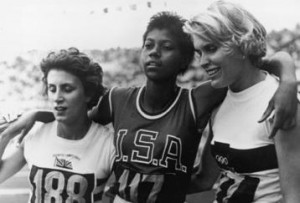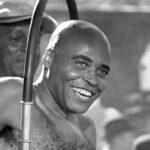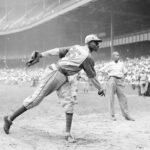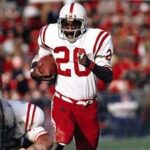The Greatest Track Meet of All-Time: 1962, USA vs. USSR

Annihilation.
Such fatalism and finality we associate with that word.
Yet in the early 1960s, that is exactly what the planet faced as the two world powers of that time postured behind their immense nuclear arsenals. Never before or since had the world been so close to self-destruction.
In the midst of those tense times, perhaps as a subliminal human survival instinct, the two powers somehow continued to participate in a popular athletic rivalry: the USA vs USSR Track and Field dual meet series.
Obviously, Earth survived.
Historians would eventually credit diplomacy, through glasnost and perestroika, with the ending of that Cold War. But at the moment when fingers in high places crept closest to that mythical red button, the 1962 USA/USSR dual track meet may have just provided the distraction which caused both sides to blink.
Soviet Premier Nikita Khrushchev had already spewed his famous “We will bury you!” tirade. The failed Bay of Pigs invasion of Cuba had President John F. Kennedy reeling on the defensive.
Only days before the meet, Soviet experts were secretly whisked to Cuba to oversee the installation of nuclear missile sites—targeting American cities. Fallout shelters and routine survival drills by school children were the order of the day. US pilot Gary Powers had recently been shot down and captured by the Soviets in the famous spy plane incident.
As if confrontation on terrestrial levels were not enough, the so-called “space race” added to the contentious spirit of the times.
It was into this atmosphere of hatred and suspicion that one of the most stirring displays of camaraderie and friendship was injected.
The people groups of the world were much less homogeneous in the early 1960s. The Soviet Union, for example, was hidden from American eyes behind a mysterious shroud of secrecy. Likewise, the Western lifestyle was intentionally shielded from the view of Soviet citizens by their Socialist Party elites.
The tremendous popularity and rivalry of the dual meet series was spawned by national pride and loyalty on both sides, and always seemed to extract the best performances from the athletes.
In the previous meeting at Lenin Stadium in 1961, four world records had been broken. Athletics stars like Wilma Rudolph, Ralph Boston, and Valery Brumel solidified their legendary status at that meet. Signalling a slight warming of foreign relations (at least on the sporting front), ABC’s Wide World of Sports was awarded for the first time an exclusive right to telecast from Moscow.
The American men won that meet, 124-111. The Soviet women won, 68-39. The meet series began in 1958 and ran in off-Olympic years almost continuously through 1985. That era was considered the “Golden Age” of track and field. Outside the Olympics, the USA vs USSR rivalry inspired more world records than any other international competition.

Mirroring that rivalry on the political stage, Khrushchev and Kennedy continued to joust, with all humanity hanging in the balance. Countering Kennedy’s failed plan to invade Cuba, Khrushchev threatened to invade democratic West Berlin. The famed Berlin Wall would later divide the city. American reconnaissance had discovered the Soviet missile sites in Cuba and a 13 day stare-down (the Cuban Missile Crisis) would later ensue.
It was a critical-mass moment in world history…and on a warm July weekend in 1962, a two-day track meet would provide the emotional escape a tense and anxious world was longing for.
The congenial tone of the meet was set by its two greatest proponents and promoters—fittingly an American and a Russian. Former world-class athlete and head track coach at Stanford, Payton Jordan and his Eastern Bloc comrade, Gavriel Korobkov, coach of the Soviet national team, conspired to stage a track meet which had implications beyond their wildest dreams. The two friends had connections reaching back 24 years.
Jordan and Korobkov worked together behind the scenes to convince the AAU (USA’s track and field governing body at the time) to override its east coast bias and hold the meet in Palo Alto, California, the site of Stanford’s campus. Jordan, who was accustomed to track crowds of 10,000 to 20,000, boldly guaranteed the meet would be a sellout and a money-maker.
Known as the “P.T.Barnum of track and field”, Jordan knew how to put on a show. He innovated his track meets with loudspeaker intros, rotating signboards, personalized jerseys and plenty of colorful banners. Aware of television’s intrusive nature, he limited ABC’s producer, Roone Arledge to two roving cameras on the field.
Perhaps Jordan’s piece de resistance was his determination to be a gracious host and welcome Korobkov’s countrymen with warm and open arms.
While negotiations in Washington and Moscow intended to diffuse a ticking time bomb were falling apart, the few days in Palo Alto leading up to the competition were a demonstration of the very best humanity has to offer.
Private homes were opened up to the Soviets. Spontaneous cross-culture pickup games of basketball and baseball broke out in parking lots and streets. Host families organized informal tours of the many attractions in the San Francisco area. Banquets and press conferences were characterized by levity and mutual respect.

The charming Soviet world-record high jumper, Valery Brumel, entertained the press by doing his famous high-kick, touching a basketball rim with his toe, ten feet above ground.
Not one protest or demonstration marred the entire week.
On Saturday, July 21, 1962, 72,500 track fans filed through the gates of Stanford Stadium. The following day, another 81,000 filled the seats. It was the greatest two-day crowd to ever witness a non-Olympic track meet.
While the enthusiastic fans were indeed partisan, any superb effort was rewarded with cheers, regardless of nationality. The Americans were especially curious to get a look at Brumel and long jumper Igor Ter-ovanesyan who had recently eclipsed Ralph Boston’s world record—and of course the famous Press sisters, Tamara and Irina.
In a manner typical of those days, the Americans dominated the sprints, middle distance, and pole vault. The Soviets ruled the longer distance races and jumping events.
The crowd got its money’s worth. “Bullet” Bob Hayes, who went on to a second career with the Dallas Cowboys, won the men’s 100 meters. His female counterpart, the great Wilma Rudolph, noted for her childhood battle with infantile paralysis, won the women’s 100 meters and, through a gutsy anchor leg, secured a dramatic come-from-behind win in the 400-meter relay.
Al Oerter, America’s ageless wonder, captured the discus. Jim Beatty, the first man to run a sub-four-minute mile indoors, withstood a Soviet strategy to burn him out early, and won the 1500 meters. Olympic champion Pyotr Bolotnikov amazed the fans with a double win in the 10,000 and 5000 meters.
Tamara Press also captured a double win for the Soviet women in the shot put and discus. Her sister, Irina, won the 80 meter hurdles. Ralph Boston tasted sweet revenge in winning the long jump. His Eastern Bloc rival, Ter-ovanesyan, who had stolen Boston’s world record only weeks earlier was a close second. Another future NFL star Paul Warfield came third.
The crowd was abuzz with the excitement of the world-class drama being played out before it. And with the atmosphere of friendship and unity pervading the stadium, the tensions of a world gone mad seemed far in the distance.
Then the aging giant Harold Connolly gave the home fans a moment to remember in the hammer throw.
Normally the hammer is contested outside the main arena for reasons of safety. Thanks to some clever intuition on Jordan’s part, for this meet Connolly had center stage. Some critics had considered Connolly a washout for his poor showing in the 1960 Rome Olympics. The fans seemed to take this criticism personally and stood in unison as “Hal” launched a missile of his own to a new world record, 231’10”.
It is probable the shouts of the crowd were heard all the way to San Jose. Connolly would later set two more world records before retiring. Washout indeed!
Even with all the incredible talent gathered in Stanford Stadium that weekend, there was no denying the main attraction at this meet was Valery Brumel. After clearing 7’2″, Brumel’s last competitor (former world-record holder, John Thomas) was out.
The bar was raised to 7’3″. Brumel cleared easily.
The bar went to 7’5″, a new world-record height.
There was silence. Then Brumel approached the pit in long strides, finally converting lateral speed into upward thrust. His lead foot rose high in the air, just like his earlier high-kick antics for the press. His body followed, barely brushing the bar. Suspense held everyone’s breath captive as the bar settled…and held.

Like a cannon’s report, 81,000 voices boomed at once. A five-minute standing ovation followed. Brumel was mobbed by Soviets and Americans. Ter-ovanesyan would later remark, “It was not two teams. It was one team.”
In the awards ceremony that followed, Tamara Press emphasized the overall goodwill with a little comic relief: when 5’3″ Harold Berlinger struggled to reach Press’s head, Tamara grabbed Berlinger by the armpits and hoisted him higher in order for him to place the medal over her head. She then sealed the deal with a kiss to his bald forehead.
If any pent-up tension remained in the crowd at that moment, it was released in a torrent of laughter.
Perhaps the most symbolic and heart-gripping moment came as the athletes prepared to exit the stadium. The plan was to exit directly through the south end, in two columns. At the head of the columns, American John Thomas and Soviet javelinist Viktor Tsybulenko held a mini summit meeting of their own and decided instead to make a final victory lap.
All the athletes followed in unison, holding hands, embracing, waving their national colors. The fans stood and cheered as the entire formation of American and Soviet athletes completed their lap, then disappeared through the south gate.
The press would report that the American men won, 128-107 and the Soviet women prevailed, 66-41. No one really cared.
And no one wanted to leave. The Marine Corps Band continued to play for nearly an hour. Tears came easily for most of the record crowd as a cleansing torrent of emotion washed over them.
Ralph Boston would later recall, “I can’t remember if the Cold War ever came into my mind at any time. All I was thinking was ‘here was this super track and field team from the other side of the world…'”
A sportswriter for the San Francisco Examiner would later describe it as “the greatest track meet of all time.”
Based solely on the athletes in attendance and their remarkable feats, an argument could be made in support of that statement. However, it’s almost certain the writer was referring to something intangible, beyond the physical plane. Something higher. Something more enduring.
* * *
Two months later, a nuclear exchange seemed imminent, as the Cuban Missile Crisis reached the boiling point. Then in October, finally, mercifully, an agreement was reached for a mutual withdrawal of missiles from Cuba and Turkey. Eventually more talks ensued, resulting in increasing stages of nuclear disarmament.
Today, the nuclear threat still exists. But now there are several modern deterrents to that threat: an increased awareness of the finality of its potential, an ever-increasing value on human life, and a realization that the good of mankind shines brightest in the darkest hours—and that good is worth saving.
Is it possible the seeds of that revelation were planted on a summer weekend in Palo Alto in 1962?
Some think so.
Primary source: Cold War, Warm Welcome by Gary Cavalli, Stanford Magazine
Other sources: S.I. Vault
Raising the Roof by Christopher Ross, ABC Sports
Stadiums by Munsey and Suppes












